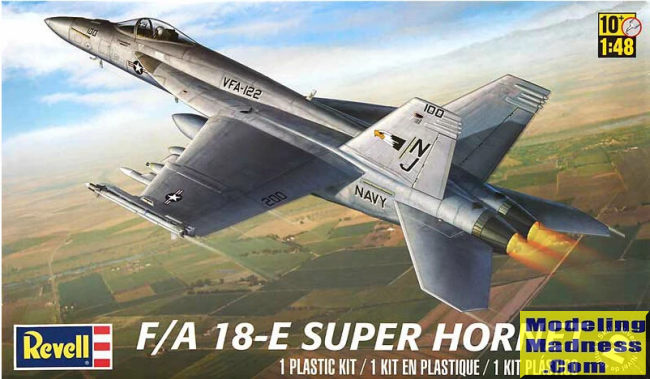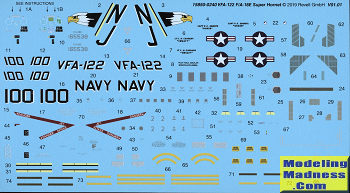
Revell 1/48 F-18E Super Hornet
| KIT #: | 5850 |
| PRICE: | ~$20.00 street prices |
| DECALS: | One option |
| REVIEWER: | Scott Van Aken |
| NOTES: | 2019 reissue |

| HISTORY |
"Following the cancellation of the A-12 Avenger, McDonnell Douglas proposed a new variant of the F-18 Hornet as a cheaper alternative to the stealth attack plane. Though sharing great commonality with the previous F-18C single-seat and F-18D two-seat models, the F-18E and F-18F have been extensively redesigned with a lengthened fuselage, 25% larger wing with room for two additional pylons, enlarged tail surfaces, and enlarged leading-edge root extensions (LERXs) for better high angle-of-attack performance. The enlarged fuselage and wing provide space for 33% more fuel capacity for greater range and endurance as well as a larger payload. Due to the increase in weight, the aircraft is fitted with more powerful General Electric F414 engines to maintain the same thrust-to-weight ratio.
Other modifications from the original F-18 include an updated cockpit complete with glass displays and more modern avionics, a new radar, simplified landing gear, and new trapezoidal inlets that provide increased airflow to the new engines while lowering the Super Hornet's radar cross-section (RCS). The design also provides room for future growth with additional space and power available for an active electronically scanned array (AESA) radar as well as the advanced targeting forward looking infrared (ATFLIR) system. Other advanced items to be installed include the multifunctional information distribution system (MIDS) and the joint helmet mounted cueing system (JHMCS), which will be used in conjunction with the high off-boresight AIM-9X missile.
Flight testing of the Super Hornet began in late 1995 with delivery of the first production aircraft several years later. Early testing revealed two significant aerodynamic problems with the aircraft. Most important of these was an uncommanded "wing drop" wherein one wing would suddenly stall without warning during certain maneuvers causing the aircraft to roll rapidly to one side. Modifications to the dogtooth as well as other wing adjustments corrected this undesirable behavior. In addition, turbulence beneath the wings was found to be so severe that it had the power to damage stores carried on the under wing pylons. This problem was corrected with a rearrangement of the under wing pylons, but at the price of increased drag and decreased performance at high speeds.
Nevertheless, the F-18E/F has otherwise proven quite successful and is currently entering service with the US Navy. Current plans call for 548 aircraft to be procured as replacements for the F-14 and F-18A by 2010 with each carrier air wing receiving 12 F-18E and 14 F-18F models. Four or five of the aircraft delivered to each wing are also to be fitted with under wing "buddy stores" to serve as in-flight refueling tankers. An additional model is the two-seat EA-18G Growler electronic warfare platform intended to replace the EA-6B Prowler jamming aircraft. Ideally, six EA-18s would equip each carrier air wing. Though the Navy would like to acquire 1,000 F/A-18E/F units to serve until at least 2030, further production will be subject to the F-35 Joint Strike Fighter program. Singapore and Malaysia have also reportedly shown interest in an export version of the F/A-18E/F."
Shamelessly pinched from www.aerospace.org
| THE KIT |
 This
kit was released about the same time as the Hasegawa kit and really, the
differences are quite obvious to those who build a lot of kits. The Hasegawa kit
has the edge in a lot of ways from more crisp engraving to a greater number of
parts and options like lowered flaps/ailerons. However, this does not mean the
Revell kit is a pig, just that it was designed for a different audience; that
audience being those who are not all the enamoured with a lot of small parts and
details. I should also mention that this is an earlier variant without the
modified cooling vents on the rear fuselage, though I think those are available
in aftermarket.
This
kit was released about the same time as the Hasegawa kit and really, the
differences are quite obvious to those who build a lot of kits. The Hasegawa kit
has the edge in a lot of ways from more crisp engraving to a greater number of
parts and options like lowered flaps/ailerons. However, this does not mean the
Revell kit is a pig, just that it was designed for a different audience; that
audience being those who are not all the enamoured with a lot of small parts and
details. I should also mention that this is an earlier variant without the
modified cooling vents on the rear fuselage, though I think those are available
in aftermarket.
The Revell kit, like the Hasegawa and other kits, is designed to do either a single or two seat variant, but does not offer both options in the same box. The cockpit has a four piece bang seat that is adequate along with a control stick and instrument panel that fit into a tub with raised console details. A decal is provided for the instrument panel if you wish it.
This fits into the lower fuselage which also contains the lower wings out to the fold line. Then one builds up the intakes which have trunking back to the first compressor stage. These are also attached to the lower fuselage half. Then the piece that allows movable stabiliators is installed before the haves are closed. The upper nose is then assembled and attached to the forward fuselage. no weight is indicated so perhaps none is required. Exhaust is attached before moving on to the landing gear.
Both main and nose gear are nicely detailed and the
gear doors all have actuator pieces to attach. Under the wings you have various
actuator pieces to attach to the flaps and ailerons. As mentioned, these latter
bits are molded in the neutral position, though there are aftermarket conversion
sets out there if you want. Wing tips are then attached. These cannot be modeled
folded without modification. Attaching the fins and stabilators completes the
main airframe. There are three pylons per wing and those are then attached. The
kit provides wing tip missiles and a centerline fuel tank. You are also provided
missiles for the outermost wing pylons and another pair if you decide not to use
the fuselage mounted targeting pods. A few other options are the ability
to have the canopy raised or lowered and there is an actuator. You can also
pose it with the boarding ladder extended.
Instructions are quite nicely done and are the style we have come to expect from Revell AG. Generic paint names are provided so you can figure out what is what without any real issues. Unlike the initial boxing of this kit, there is only one marking option and that is the box art plane, which is the CAG bird of VFA-122. Decals are nicely printed and should prove useful. There are a plethora of aftermarket sheets if you want something different, which I'll bet most folks will.
| CONCLUSIONS |
I know that this is not the first choice for many modelers. There are issues with the size of the fins, which are too small. Some decal makers even offer separate fin markings just for this kit. There is also the lack of wing mounted fuel tanks that is bothersome as most Super Bugs carry them. One also has to dig around for ordnance to fill the empty pylons.
However, as mentioned, this is not for the dedicated SH builder, but those who want one on the shelf and are not too concerned about having a lot of small detail parts. I've seen this built and for the budget conscious modeler, this is a perfect match.
July 2020
Copyright ModelingMadness.com. All rights reserved.
If you would like your product reviewed fairly and fairly quickly, please contact the editor or see other details in the Note to Contributors.